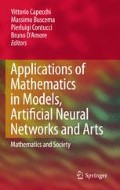Abstract
Living in a three-dimensional world, it is quite difficult for us to imagine a fourth geometric dimension, perpendicular to the three we already know. But a 4D geometry does not break any mathematical rule and indeed mathematicians have been studying it since the eighteenth century. Ideas referring to a 4D world have then spread beyond the math world and have inspired painters, sculptors, writers, and architects. Modern computer graphics allows us to get some more insight into this fascinating world.
Access this chapter
Tax calculation will be finalised at checkout
Purchases are for personal use only
Notes
- 1.
Hypercube, Wikipedia, The Free Encyclopedia, <http://en.wikipedia.org/wiki/Hypercube> Hypercube, from MathWorld, Eric W. Weisstein, <http://mathworld.wolfram.com/Hypercube.html>
- 2.
The word hypersphere can in general describe any higher-dimensional analog of the sphere (i.e., spheres in four, five, six, etc. dimensions).
- 3.
3-sphere, Wikipedia, The Free Encyclopedia. <http://en.wikipedia.org/w/index.php?title=3-sphere%26oldid=208966785> Hypersphere, from Math World, Eric W. Weisstein, <http://mathworld.wolfram.com/Hypersphere.html>
- 4.
120-cell, Wikipedia, The Free Encyclopedia, <http://en.wikipedia.org/wiki/120-cell>120-cell, from MathWorld, Eric W. Weisstein, <http://mathworld.wolfram.com/120-Cell.html>
- 5.
Bonds of Friendship, J. Robinson, <http://www.bradshawfoundation.com/jr/bonds_of_friendship.php>
Bibliography
Abbot, E. A. (2008). Flatland: A romance of many dimensions. Oxford world’s classics. Oxford: Oxford University Press. [Full text is available on the web: <http://www.gutenberg.org/etext/97>]
Coxeter, H. S. M. (1973). Regular polytopes. New York: Dover.
Coxeter, H. S. M. (1991). Regular complex polytopes. Cambridge: Cambridge University Press.
Dalì, S. (1954). Crucifixion (Corpus Hypercubus). oil on canvas 194.5 × 124 cm. New York: Metropolitan Museum of Art.
Egginton, W. (April 1999). On Dante, Hyperspheres, and the curvature of the medieval cosmos. J. Hist. Ideas 60,(2), 195–216.
Heinlein, R. (1941). —And he built a crooked house. In Astounding Science Fiction.
Kemp, M. (1988). Dalì’s dimensions. Nature 391(27), doi:10.1038/34063
Robbins, T. (1992). Computers, art & the 4th dimension. A Bulfinch Press Book, ISBN: 0-8212-1909-X.
Robinson, J. (1979). Bonds of friendship. Polished bronze 5 ft × 3 ft, Circular Quay, Sydney Cove, NSW, Australia.
Stringham, W. (1880). Regular figures in n-dimensional space. Am. J. Math 2(1 Mar), 1–14.
Osserman, R. (1996). Poetry of the universe. New York: Anchor Books/Doubleday.
Author information
Authors and Affiliations
Corresponding author
Editor information
Editors and Affiliations
Rights and permissions
Copyright information
© 2010 Springer Science+Business Media B.V.
About this chapter
Cite this chapter
Todesco, G.M. (2010). Four-Dimensional Ideas. In: Capecchi, V., Buscema, M., Contucci, P., D'Amore, B. (eds) Applications of Mathematics in Models, Artificial Neural Networks and Arts. Springer, Dordrecht. https://doi.org/10.1007/978-90-481-8581-8_26
Download citation
DOI: https://doi.org/10.1007/978-90-481-8581-8_26
Published:
Publisher Name: Springer, Dordrecht
Print ISBN: 978-90-481-8580-1
Online ISBN: 978-90-481-8581-8
eBook Packages: Humanities, Social Sciences and LawSocial Sciences (R0)

